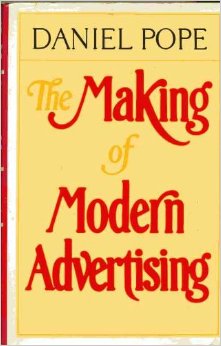Will marketers be shifting more of their advertising in-house and away from traditional advertising agencies?
 A recent report by the Association of National Advertisers found that more than half of the companies surveyed were developing their advertising strategies within the company rather than relying on outside agencies. The two factors contributing to this shift are 1) economic pressures to reduce costs, and 2) the growth of digital media, which requires a much faster response to change than legacy media.
A recent report by the Association of National Advertisers found that more than half of the companies surveyed were developing their advertising strategies within the company rather than relying on outside agencies. The two factors contributing to this shift are 1) economic pressures to reduce costs, and 2) the growth of digital media, which requires a much faster response to change than legacy media.
The advertising historian Daniel Pope, The Making of Modern Advertising, studied the rise of the modern advertising agency in the late 19th and early 20th centuries and asked why agency functions (space brokering, copywriting, and marketing advice) were not incorporated within in-house departments at marketers instead. Once agencies and publishers agreed to share information about circulation and rates, agencies no longer held a monopoly on that information, losing key leverage over marketers. Yet, ad agencies became the facilitators for national advertisers. Ad agencies claimed that their “independent judgment” was the primary reason that advertisers turned to them instead of keeping their advertising in-house.
 Pope argues that it was the rise of the commission system that led to the establishment of ad agencies independent of advertisers. Under the commission system, advertisers paid for media only, with the agency as the broker; the agency then deducted a commission of 15% from that before forwarding it to the publisher. Agencies supplied copywriting, art direction, and market research to advertisers without billing for those services. To publishers, agencies promised customers. To advertisers, agencies promised special expertise and leverage to negotiate good media prices with publishers. Agencies also pressured publishers to discriminate against advertisers not using agencies. This system made it difficult for advertisers to design advertisements in-house and then purchase media services separately.
Pope argues that it was the rise of the commission system that led to the establishment of ad agencies independent of advertisers. Under the commission system, advertisers paid for media only, with the agency as the broker; the agency then deducted a commission of 15% from that before forwarding it to the publisher. Agencies supplied copywriting, art direction, and market research to advertisers without billing for those services. To publishers, agencies promised customers. To advertisers, agencies promised special expertise and leverage to negotiate good media prices with publishers. Agencies also pressured publishers to discriminate against advertisers not using agencies. This system made it difficult for advertisers to design advertisements in-house and then purchase media services separately.
In the 1990s, the commission system broke down as advertising conglomerates spun off media buying into agencies separate from creative agencies. Today creative agencies, the agencies that develop the creative concept and provide copywriting and art direction, do not charge a commission but bill by employee time or project time. Without the carrot and stick of media buying leverage, the creative agencies are very vulnerable. Might this ANA report on the rise of in-house agencies indicate that vulnerability is growing?
Under the commission system, agencies did not have to quantify their creative work because it was cross-subsidized by media commissions. Today, advertisers believe that creativity can be found in multiple places, including media agencies. As advertisers expand their search for creative solutions to the problem of attracting audiences, many of them may also turn inward and save themselves the cost of paying outside agencies.



Pingback: How I Got Ahead In Advertising | Toronto@Home
Pingback: Why use an agency? | elizalittleprm